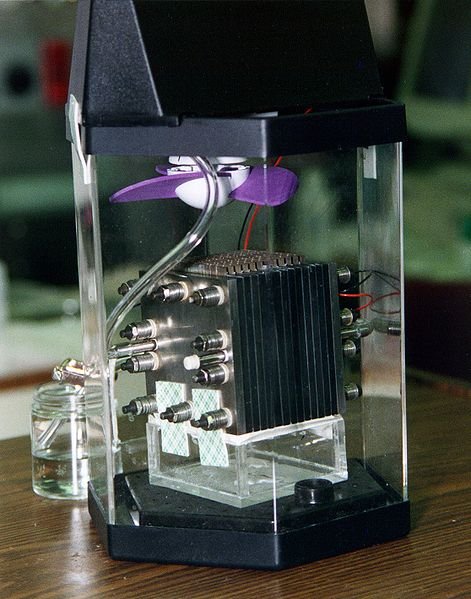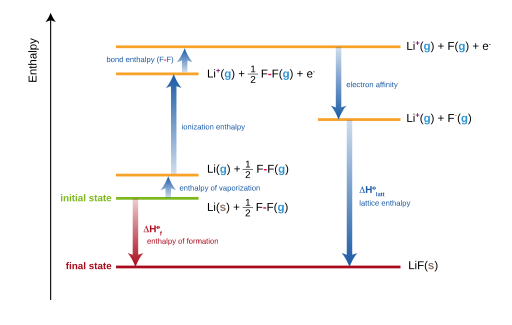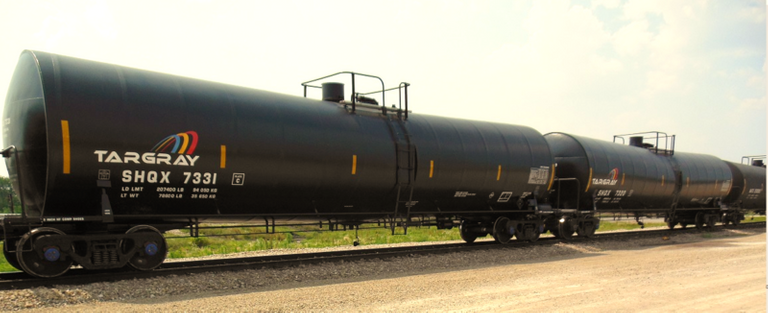FUELS, ENERGY CHANGES AND RATES OF REACTION
World supplies of oil are likely to run out before the end of the 21st century, but by then other energy sources should have been developed. A possibility is hydrogen, derived from water. Hydrogen has several advantages: when it burns it produces no harmful products, it gives out more energy per gram than natural gas or petrol, and existing car engines need only minor modifications to use it as a fuel. Hydrogen has become a fuel in space exploration: the US Space Shuttle piggy-backs a lift on giant tanks that contain 1.74 million litres of liquid hydrogen and 0.65 million litres of liquid oxygen. This fuel supplies the shuttle’s main engines.

The reason splitting water to obtain hydrogen isn’t done on a large scale yet is that the process requires energy. In some countries, this would have to come from burning fossil fuels, which would cancel out any environmental advantages.
Alternatively, more efficient solar cells are under development using nano-particle coatings to capture the energy from sunlight and produce an electric current. However, the cells are not yet efficient enough to make hydrogen economically. The possibility of producing hydrogen from the photosynthetic reactions of genetically modified algae is also being investigated, but so far the algae produce too little hydrogen to make this project commercially viable.
Another problem is how to carry hydrogen around, since to stay liquid and occupy a convenient volume it would have to be stored below -253°C. Hydrogen is dangerous to transport, as the Hindenburg disaster of 1937 showed. The Hindenburg was a hydrogen-filled airship that blew up, killing 35 people.One promising area of research is the use of metal hydrides (solid compounds of a metal and hydrogen): the hydrogen could be produced from them as needed by heating.
WHAT IS A FUEL?
A fuel is a substance that releases energy that can do work. Most fuels release this energy during combustion reactions. So what properties make an ideal fuel? Petrol is a popular fuel, but is it ideal?
For its mass, petrol produces a lot of energy, which makes the expense transporting and storing it worthwhile. It does not produce solid waste tha needs to be dumped. But an ideal fuel produces no harmful by-products when it burns, and petrol does. Even if the by-products were just carbon dioxide and water, we now know that carbon dioxide is a major greenhouse gas and its continued output at today’s levels is leading to global warming.

HOW A FUEL RELEASES ITS ENERGY: EXOTHERMIC REACTIONS AND ENTHALPY CHANGES
When natural gas burns it releases its energy to the surroundings, which could be the water in a central heating system. This is an exothermic reaction between methane (in natural gas) and oxygen.
CH4(g) + 2O2(g) → CO2(g) + 2H2O (l) ΔHꝋ298 = -890 kJ mol-1
The stored energy of the reactants, methane and oxygen, is higher than the stored energy of the products of the reaction, carbon dioxide and water. The difference in energy is released to the surroundings when methane and oxygen react. State symbols should always be shown in chemical equations when dealing with energy from chemical reactions. The enthalpy change responsible for gaseous water (steam) being produced is not the same as the enthalpy change responsible for liquid water being produced. State symbols are: (s) = Solid, (l) = liquid, (g)= gas (aq)= aqueous
STANDARD CONDITIONS
The symbol ꝋ tells us that the conditions for this enthalpy change are standard conditions at a particular temperature. Standard conditions are 100 kPa (1 atmosphere) pressure and, for solutions, a concentration of 1 mol dm-3. The particular temperature for these standard conditions is usually 298 K (25°C). A small 298 following ΔHꝋ (pronounced ‘delta H standard’) shows that the standard temperature is used. The substances in the chemical reaction (the reactants and products) are known as the system, and all substances in the system are in their standard states. The standard state is the most stable physical state at 1 atmosphere pressure and the particular temperature, usually 298 K (25°C). So the standard state of methane is a gas and the standard state of water is a liquid.
Enthalpy, H, is the stored energy in a compound. Enthalpy changes are transfers of energy into or out of the system at constant pressure. ΔH (pronounced ‘delta H’) is the enthalpy change of the reaction. It is measured under conditions of constant pressure. In exothermic reactions, ΔH is negative. In endothermic reactions, ΔH is positive. kJ mol-1 means the energy released per mole of equation. This means the mole quantities given in the equation release so many kilojoules.
Standard enthalpy change of a reaction is the enthalpy change under standard conditions at 298 K and 100 kPa, with all substances in their standard states. This refers to the mole quantities given in the balanced equation for the reaction. The surroundings are everything that is not the system. It could be the reaction vessel, the air around the reaction vessel, the liquid in a thermometer and anything else that is not a reactant or product. But the surroundings must be associated thermally with the system, which means that heat can transfer between system and surroundings.
STANDARD ENTHALPY CHANGE OF COMBUSTION
Methane burning in oxygen is called a combustion reaction. The enthalpy change is an enthalpy change of reaction, but if we burn one mole of methane completely in oxygen it can also be referred to as an enthalpy change of combustion.
Standard enthalpy change of combustion ΔHꝋc, 298 is the enthalpy change when one mole of a substance burns completely in oxygen under standard conditions (298 K and 100 kPa) with all reactants and products in their standard state. You will sometimes see the standard enthalpy change of reaction written as the standard molar enthalpy change of reaction. Similarly, the standard enthalpy change of combustion is some times called the standard molar enthalpy change of combustion. Some definitions of standard enthalpy change use a standard pressure of 101.3 kPa.
So the standard enthalpy change of combustion of methane is written:
ΔHꝋc, 298 (CH4) = -890 kJ mol-1
And because the standard temperature is 298 K, we often wríte:
ΔHꝋc = -890 kJ mol-1
In the definitíon for standard enthalpy change of combustion it says burns completely to show clearly that only carbon dioxide and water are formed. With not enough oxygen, there may be incomplete combustion, which would produce carbon monoxide or even carbon (soot). The enthalpy changes for both these reactions will affect any measurement of enthalpy change of combustion.

In practice, when methane burns in oxygen, the temperature is much higher than 25 °C, so adjustments must be made to calculate the value under standard conditions.
EXAMPLE
Explain fully what is meant by:
ΔHꝋc, 298 (H2) = -286 kJ mol-1
ANSWER
This is the standard enthalpy change of combustion of hydrogen. It is the enthalpy change when one mole of hydrogen is completely burnt in oxygen under standard conditions of 100 kPa pressure and 298 K, with reactants and products in their standard states at this temperature.
H2(g) + ½ O2(g) → H2O(l) ΔHꝋc = -286 kJ mol -1
Notice that this includes the state symbols. Also, ½ O2 does not mean half a molecule of oxygen, but half a mole. I could have written:
2H2(g) + O2(g)→ 2H2O(l) ΔHꝋr = -572 kJ mol -1
The standard enthalpy change of this reaction, ΔHꝋr (small r for reaction; or just ΔHꝋ) is twice that for the standard enthalpy change of combustion of hydrogen. This is because ΔHr, applies to the mole quantities in the equation – 2 moles of hydrogen –whereas the standard enthalpy change of combustion is for burning one mole of hydrogen.
ALTERNATIVE FUELS TO PETROL
The standard enthalpy changes of combustion of some fuel alternatives to petrol are: -286 kJ mol -1 for hydrogen, -890 kJ mol -1 for compressed natural gas (CNG), -2219 kJ mol -1 for liquid petroleum gas (LPG), -726 kJ mol -1 for methanol and -1367 kJ mol -1 for ethanol. There is no standard enthalpy change for petrol because it is a complex mixture of about 100 compounds, mainly hydrocarbons, or which most are alkanes. The standard enthalpy change of combustion of octane, one of the constituents of petrol, is -5470 kJ mol -1, which is a good indication of why petrol is used in cars.
Biofuels
Biofuel’s are fuels that are made from the products of living things, usually plants. Biodiesel and bioethanol are two biofuels whose production is increasing rapidly, as countries seek alternatives to fossil fuels to power vehicles and reduce carbon dioxide emissions. In 2010 the British government requires that 5 per cent of all fuel sold at the pump must be biofuels. The United States is also intending to dramatically increase its use of biofuels in vehicle transport.

Sugar cane and wheat can be fermented to produce ethanol, which is blended with petrol or used on its own. There is enough fuel in a field of wheat the size of a football pitch to run a family car for 12 000 miles. One source of biodiesel is oilseed rape.
Growing crops for fuel is the subject of heated debate. Some people say biofuels are the answer to increasing levels of carbon dioxide in the atmosphere: the crops remove carbon dioxide from the air to make sugars and oils, and the gas returns to the atmosphere when fuels made from the crops are burnt, so there is no net carbon dioxide increase. This means that biofuels could be called carbon neutral. But other analysts point out that this ignores the fossil fuels that must be burnt to provide the fuel for planting making the fertilizer, and for harvesting, transporting and processing the crop. In this case biofuels are definitely not carbon neutral.
There are also concerns that using agricultural land to grow fuel crops will lead to less food crops and therefore food shortages in some parts of the world.
In my next post, I will discuss how to measure enthalpy changes with suitable examples and also on how energy is released from fuel molecules.
Thanks for reading.
REFERENCES
https://www.ecotricity.co.uk/our-green-energy/energy-independence/the-end-of-fossil-fuels
https://www.renewableenergyworld.com/types-of-renewable-energy/hydrogen/
https://afdc.energy.gov/fuels/hydrogen_basics.html
https://en.wikipedia.org/wiki/Hydrogen_fuel#:~:text=Hydrogen%20fuel%20is%20a%20zero,a%20fuel%20for%20spacecraft%20propulsion.
https://www.toppr.com/guides/chemistry/combustion-and-fuel/introduction-to-fuel-and-fuel-efficiency/
https://en.wikipedia.org/wiki/Fuel
https://chem.libretexts.org/Courses/Valley_City_State_University/Chem_121/Chapter_7%3A_Thermochemistry/7.4%3A_Standard_Enthalpy_of_Formation#:~:text=The%20standard%20enthalpy%20of%20formation,elements%20under%20the%20same%20conditions.
https://chemicalstatistician.wordpress.com/tag/standard-conditions/
https://en.wikipedia.org/wiki/Standard_conditions_for_temperature_and_pressure#:~:text=Standard%20conditions%20for%20temperature%20and%20pressure%20are%20standard%20sets%20of,between%20different%20sets%20of%20data.&text=Until%201982%2C%20STP%20was%20defined,1%20atm%20(101.325%20kPa).
https://www.chemguide.co.uk/physical/energetics/sums.html
https://www.weforum.org/agenda/2015/12/6-alternatives-to-petrol/
https://en.wikipedia.org/wiki/Alternative_fuel#:~:text=Some%20well%2Dknown%20alternative%20fuels,propane%20and%20other%20biomass%20sources.
https://www.britannica.com/technology/biofuel
https://en.wikipedia.org/wiki/Biofuel
https://www.shell.com/energy-and-innovation/new-energies/biofuels.html#:~:text=Biofuels%20are%20a%20renewable%20energy,such%20as%20gasoline%20and%20diesel.
Thanks for your contribution to the STEMsocial community. Feel free to join us on discord to get to know the rest of us!
Please consider supporting our funding proposal, approving our witness (@stem.witness) or delegating to the @stemsocial account (for some ROI).
Please consider using the STEMsocial app app and including @stemsocial as a beneficiary to get a stronger support.